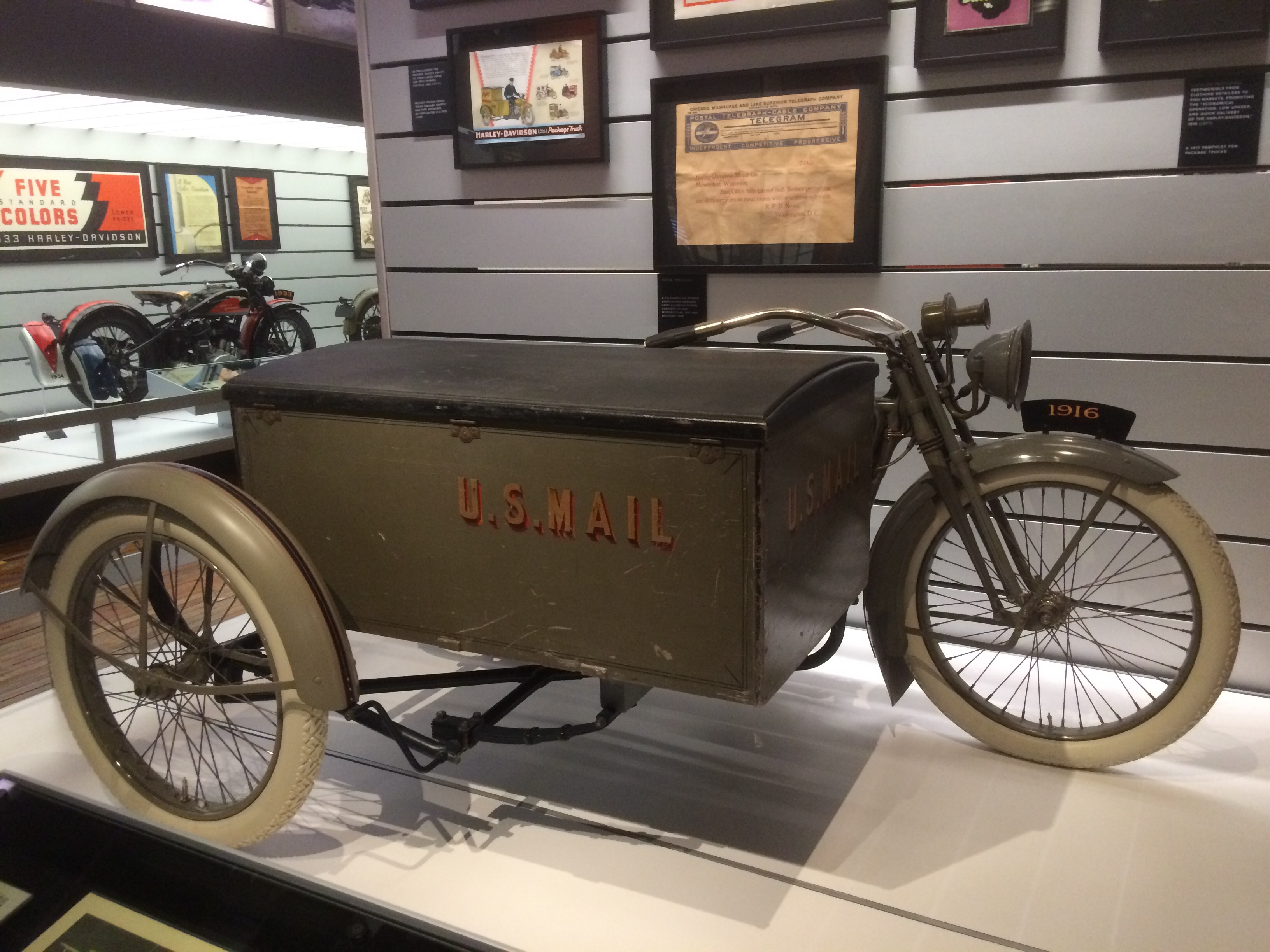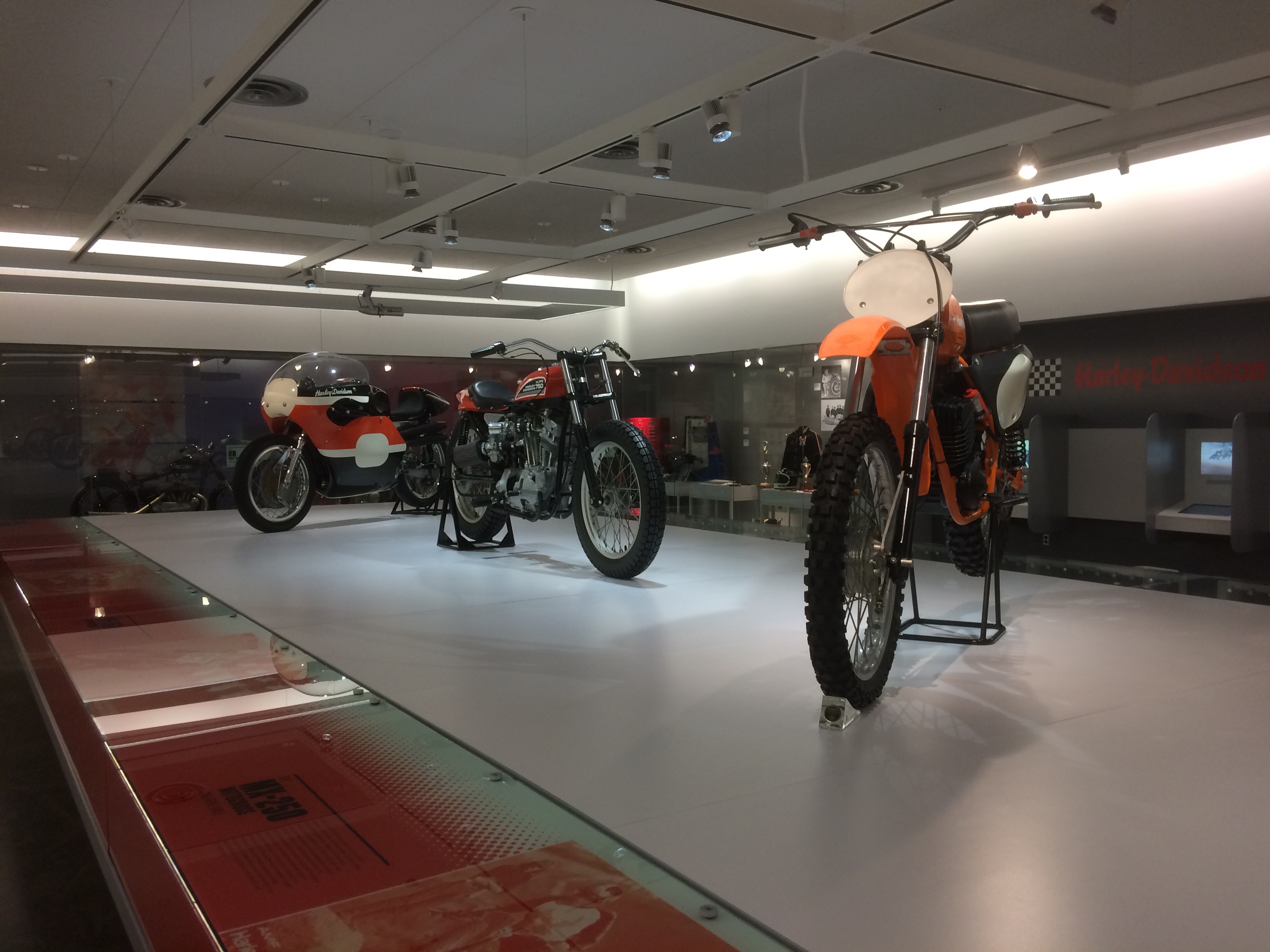 America’s longest running motorcycle company needs little promotion, as its logo and bikes are Iconic. Yet, a museum exhibiting a menagerie of bikes it has produced, its many business ventures, popular sporting events and its place in pop culture makes even the passive fan want to follow the open road. At least, that’s how I felt when I left. In this place, I couldn’t pick just one artifact, or point of interest for that matter, and say, “Yes,that was my favorite.” It’s hip and cool, plus there are enough bikes and memorabilia to make your head spin. I’m talking of the Harley-Davidson Museum located near downtown Milwaukee, Wisconsin.
America’s longest running motorcycle company needs little promotion, as its logo and bikes are Iconic. Yet, a museum exhibiting a menagerie of bikes it has produced, its many business ventures, popular sporting events and its place in pop culture makes even the passive fan want to follow the open road. At least, that’s how I felt when I left. In this place, I couldn’t pick just one artifact, or point of interest for that matter, and say, “Yes,that was my favorite.” It’s hip and cool, plus there are enough bikes and memorabilia to make your head spin. I’m talking of the Harley-Davidson Museum located near downtown Milwaukee, Wisconsin.
 I’ve blogged about a few specialty museum’s related to one industry or another. However, I’ve never blogged about a place centered around one specific company. I mean, c’mon, really, how self-serving is that? To top it off, the admission was the highest I’ve paid for entrance into any museum I’ve blogged about. Before you stop reading in disgust, let me just say, this motor shrine left me with the most profound high I’ve felt leaving a facility.
I’ve blogged about a few specialty museum’s related to one industry or another. However, I’ve never blogged about a place centered around one specific company. I mean, c’mon, really, how self-serving is that? To top it off, the admission was the highest I’ve paid for entrance into any museum I’ve blogged about. Before you stop reading in disgust, let me just say, this motor shrine left me with the most profound high I’ve felt leaving a facility.
I meander through the doors, impressed by a vast open room that is bordered with black lacquered walls-one lone bike stands at the opposite end. As I make my way through this refreshing lobby, being a break from traffic on congested city streets, I find the ticket counter and pay a friendly attendant. She directs me towards a rudimentary, unpainted, steel grated staircase that I climb to a mostly empty, glass-paneled hall.
 As I wander through the hall, nonchalantly glimpsing a few trophy cases, I stumble upon another attendant who collects my ticket. I walk in and discover the humblest of specimens, leading off a procession of chronologically ordered vintage motorcycles, as they are centered in a sleek and elegant passage. I inspect some along with their respective placards, when I notice Serial Model Number One, cased in glass in an exhibit room behind me.
As I wander through the hall, nonchalantly glimpsing a few trophy cases, I stumble upon another attendant who collects my ticket. I walk in and discover the humblest of specimens, leading off a procession of chronologically ordered vintage motorcycles, as they are centered in a sleek and elegant passage. I inspect some along with their respective placards, when I notice Serial Model Number One, cased in glass in an exhibit room behind me.
 Serial Model Number One appears as modest as many of the motorcycles leading off the seemingly endless line of bikes. Yet, this piece is a topic for debate. It is claimed to be the oldest Harley Davidson remaining, However, the engine is like no other Harley of its time and the frame is not original to the bike. Still, it’s pretty cool.
Serial Model Number One appears as modest as many of the motorcycles leading off the seemingly endless line of bikes. Yet, this piece is a topic for debate. It is claimed to be the oldest Harley Davidson remaining, However, the engine is like no other Harley of its time and the frame is not original to the bike. Still, it’s pretty cool.
 I now survey the rest of this exhibit area and the adjoining chambers, as this area has the feel of an antiquated museum. There is a rare collection of bikes, as the many early business endeavor’s and early uses of the company’s motorcycles are highlighted here. In this place, I’m exposed to trikes for towing automobiles, sidecars for delivering mail and army model prototypes that never saw the assembly line. This wide array of vehicles, along with steady government contracts, provided Harley-Davidson stability and growth in the early years.
I now survey the rest of this exhibit area and the adjoining chambers, as this area has the feel of an antiquated museum. There is a rare collection of bikes, as the many early business endeavor’s and early uses of the company’s motorcycles are highlighted here. In this place, I’m exposed to trikes for towing automobiles, sidecars for delivering mail and army model prototypes that never saw the assembly line. This wide array of vehicles, along with steady government contracts, provided Harley-Davidson stability and growth in the early years.
 I find a darkened early motor sports exhibit, which is just as interesting, on the other side of the continuous train of early 20th century bikes. There are features such as the motordrome, a large and dangerous banked wood track that mimicked the velodrome used for bicycle racing. Other exhibits include long distance races and hill climbers, all very popular, now largely forgotten novelties. The company was quick to sponsor talented participants, realizing this was a great promotional tool.
I find a darkened early motor sports exhibit, which is just as interesting, on the other side of the continuous train of early 20th century bikes. There are features such as the motordrome, a large and dangerous banked wood track that mimicked the velodrome used for bicycle racing. Other exhibits include long distance races and hill climbers, all very popular, now largely forgotten novelties. The company was quick to sponsor talented participants, realizing this was a great promotional tool. In 1933, a dark time for the company and the country in general, the prices of motorcycles were declining. As a result, Harley-Davidson could not afford to make technological advancements to their bikes. From that came the decision to, instead, focus on the aesthetics of the bike, which actually tripled their sales. One huge point of interest was the gas tank, which has remained a focal point on cycles to this day.
In 1933, a dark time for the company and the country in general, the prices of motorcycles were declining. As a result, Harley-Davidson could not afford to make technological advancements to their bikes. From that came the decision to, instead, focus on the aesthetics of the bike, which actually tripled their sales. One huge point of interest was the gas tank, which has remained a focal point on cycles to this day.
As I follow the hall lined with gas tanks I find an elevator leading to this room. An archive, if you will, of motorcycles and memorabilia. 
I now head down stairs, but before I leave the top floor, I have to mention that there is also an exhibit featuring some of the more prolific engines of the past. I don’t linger here long because I’m really not much of a gearhead. However, the progression through the ages is quite remarkable.
 When I reach the lower floor, I’m amazed. The parade of bikes continues along the opposite wall, this time featuring the latter half of the 20th century to modern day, as a large exhibit on Harley’s place in pop culture is front and center. This includes the history of outlaw biker gangs, a bike used in the Marvel Studios movie ‘Captain America’, and a meticulously replicated chopper from ‘Easy Rider’.
When I reach the lower floor, I’m amazed. The parade of bikes continues along the opposite wall, this time featuring the latter half of the 20th century to modern day, as a large exhibit on Harley’s place in pop culture is front and center. This includes the history of outlaw biker gangs, a bike used in the Marvel Studios movie ‘Captain America’, and a meticulously replicated chopper from ‘Easy Rider’.
 Around the corner, as there are exhibits of lesser known ventures such as a failed attempt at the snowmobile market during the 70’s and a successful golf cart line, I discover this bike.
Around the corner, as there are exhibits of lesser known ventures such as a failed attempt at the snowmobile market during the 70’s and a successful golf cart line, I discover this bike.
This stands as a haunting testament that, even as early advertisements claimed motorcycle’s were a way to conquer mother nature, the elements still have the upper hand. This motorcycle was inside a large trailer box when the tsunami that devastated Northeast Japan, in 2011, washed it out to sea. Over a year later, it was discovered on a remote Canadian Island. Mr. Yokoyama, the bike’s owner, lost mostly everything, including family members, due to that event. He has donated the Bike to the Museum as memorial to those who not only lost their possessions, but their lives, on that dreadful day.
 I double back, checking the long train of bikes. From70’s racing bikes to V-rods, the line showcases the last half of the twentieth century and beyond. This bottom half of the museum is chuck full of bikes, from dirt bikes to Buels. It’s hard to take in everything.
I double back, checking the long train of bikes. From70’s racing bikes to V-rods, the line showcases the last half of the twentieth century and beyond. This bottom half of the museum is chuck full of bikes, from dirt bikes to Buels. It’s hard to take in everything.
 At the end, as I realize I must call it a day, I am excited and satisfied. There are so many remarkable bikes, leather jackets, racing shirts and posters I don’t know if there is a way I could remember all of them. On the grounds, there is also a gift shop filled with great Harley memorabilia and a hip restaurant. See the museum and experience the bikes and culture that made Harley-Davidson legendary.
At the end, as I realize I must call it a day, I am excited and satisfied. There are so many remarkable bikes, leather jackets, racing shirts and posters I don’t know if there is a way I could remember all of them. On the grounds, there is also a gift shop filled with great Harley memorabilia and a hip restaurant. See the museum and experience the bikes and culture that made Harley-Davidson legendary.



Leave a comment